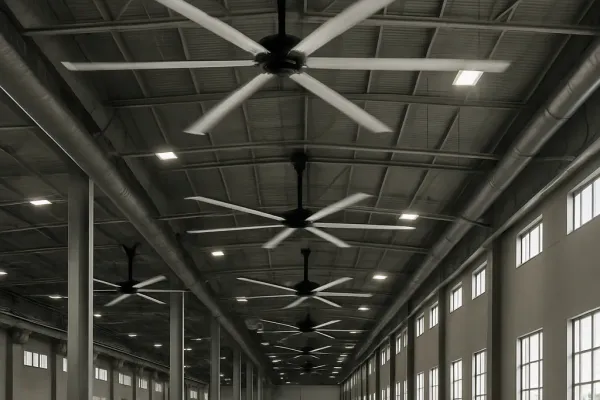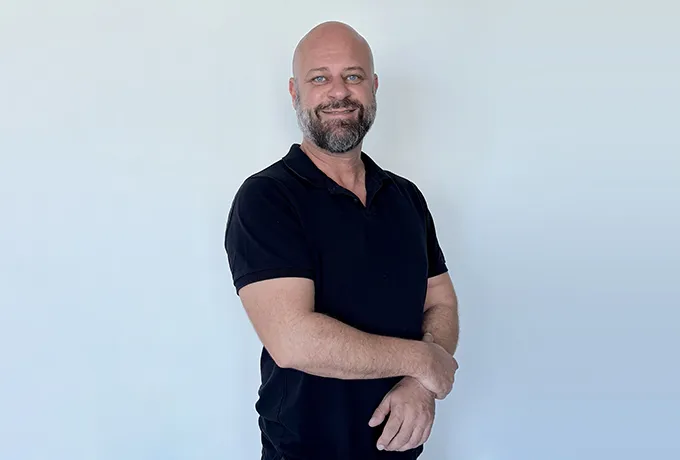Hot spots in summer. Cold floors in winter. Stale, still air year-round. These problems drain energy and slow work. A properly sized ventilador de techo industrial—specifically an Ventilador HVLS—to destratify warm air, boost flujo de aire, and cut HVAC runtime.
High-efficiency industrial ceiling fans (often Ventilador de techo HVLS systems) use wide blades turning slowly to move large volumes of air across big spaces. By destratifying aire caliente in winter and improving movimiento del aire in summer, these ventiladores industriales improve comfort and reducir la energía use. Correct sizing, smart controls, and safe instalación de ventilador de techo deliver reliable savings in factories, warehouses, gyms, and other espacios industriales.
Un ventilador de techo industrial is a large-diameter, low-speed machine that sweeps grandes volúmenes de aire with minimal power. The wide airfoil blades and efficient motor generate steady flujo de aire at low tip speeds, spreading comfort across large areas without drafts. These “Ventiladores de gran volumen y baja velocidad” are designed for large rooms with techos altos and heavy use.
In our commissioning visits, an ingeniero verifies mounting height, blade clearance, and industrial overhead structure. The sistema de ventilador pushes a gentle column of air down, then outward along the floor, returning upward along the walls. This loop mixes aire caliente trapped at the techo, reducing temperature differences (destratification) so HVAC doesn’t work as hard. That improved air circulation is what Los ventiladores están diseñados to deliver for rendimiento óptimo.
Learn more about product families: our M650 series HVLS ceiling fans y ventiladores de techo comerciales for varied fan options.

What is an industrial ceiling fan and how does it work?
Los ventiladores HVLS están construidos mover cantidades masivas de aire quietly and efficiently. The large diameter and slow rotation create a broad “river” of air that raises evaporative cooling at skin level in warm months and returns aire caliente to the floor in winter. Independent and industry sources consistently link HVLS with better comfort and lower bills. For example, ASHRAE documents desestratificación savings and thermal comfort in large buildings, while DOE sets performance expectations for ventilador de techo eficiencia.
From sports courts to distribution hubs, industrial ceiling fans are designed to work alongside HVAC—Los fans ayudan the system by mixing air so it conditions less. That’s why los ventiladores industriales están diseñados with broader coverage than small ventiladores direccionales: one big unit can move large volumes of air with less consumo de energía.
See applications: Warehouse HVLS fans application guide y big commercial ceiling fans for commercial buildings.
En un depósito or gym, still zones form behind racks, bleachers, and equipment. A well-placed ventilador de techo breaks that up, creating consistent movimiento del aire y calidad del aire benefits: fewer stagnant pockets, less condensation on cool surfaces, and less stratification that causes complaints. In short, the ceiling fan provides even comfort.
In fitness centers and espacios comerciales, we often pair an Ventilador HVLS with make-up air so fans keep the floor area fresh while HVAC handles temperature. This pairing is ideal for large rooms because the cantidad de aire we’re mixing is huge, and fans are built to last con industrial grade components.
Real-world fit: Commercial ceiling fans for sports centers and a quiet fan for large courts. Also review quiet HVLS fan guidance for commercial use.
Elección de la ventilador derecho isn’t guesswork. We start with superficie en metros cuadrados, mounting height, obstructions, and target airspeed at occupant level (typically 2–4 fps for comfort). Many industrial ceiling fans cover very gran abierto zones; others require varios fans for even coverage like warehouses with aisles.
Rule-of-thumb table (illustrative):
| Space type | Typical ceiling | Recommended diameter | Typical coverage per fan* |
| Fitness/Gym floor | 24–35 ft | 16–20 ft | 8,000–15,000 sq ft |
| Factories and warehouses | 30–45 ft | 18-24 pies | 12,000–30,000 sq ft |
| Aircraft/Logistics bay | 40–60 ft | 20–24 pies | 20,000–35,000+ sq ft |
*Coverage varies with obstacles, techo height, and target airspeed.
Industrial ceiling fans are typically installed 10–15 ft below the roof structure with downrods to clear beams. If you have odd floorplates or mezzanines, a mix of one big unit and smaller ventiladores de baja velocidad may be the soluciones para ventiladores Necesitas.
Explore models: M750 series HVLS fans for warehouse use y ventiladores de techo industriales para fabricación.
Safe instalación de ventilador de techo matters. Structural checks, seismic bracing where required, and certified hardware ensure the unit is designed to handle dynamic loads. Our ingeniero team verifies torque, electrical, and control integration so the ventilador proporciona predictable performance.
A common request is “fans without lights” for an industrial look and minimal maintenance—perfect for configuraciones industriales where luminaires are handled separately. For corrosive or humid zones, consider coated blades or stainless hardware. Industrial ceiling fans include safety cables, guy wires (as required), and UL/ETL listings.
Mounting options: see Ventilador de techo colgante galvanizado for robust suspension kits.

Ceiling fan installation and safety in industrial settings
Mixing reduces delta-T between ceiling and floor, so heating systems cycle less. ASHRAE materials and presentations report that destratification can save up to ~25% on heating and notable cooling savings by improving ventilation effectiveness—key for big buildings with techos altos. DOE also outlines standards driving better Eficiencia energética en ventilador de techo tecnología.
In summer, fans reduce energy by raising perceived cooling (≈2–4°C / up to ~alto volumen comfort effect) so thermostats can be set higher without comfort loss; heating months see aire caliente brought down from the techo, trimming gas or electric heat runtime. Manufacturers such as Fans de culo grande and others publish design notes showing reduced HVAC consumo de energía when fans and AC run together.
Quick reference table: comfort & savings factors
| Temporada | What the fan does | Practical effect | Typical result |
| Cooling | Amplio flujo de aire over occupants | Higher evaporative cooling | Higher setpoint, lower AC runtime |
| Heating | Circulating air to destratify | Even temps from floor to techo | Less heat loss at roof, lower fuel use |
| Ventilación | Mixes supply with room air | Fewer stagnant zones | Mejor entorno laboral calidad |
Applications of industrial air systems span manufacturing, logistics, sports, agriculture, and retail. Industrial HVLS fans mover grandes volúmenes de aire gently, making them ideal for large footprint rooms where ductwork cannot reach. They’re also great in espacios comerciales where noise must stay low.
En un instalación industrial, we often supplement process ventilation. Los ventiladores están diseñados to team with heaters or DX units; even a single unit can cover a surprising superficie en metros cuadrados when sized correctly. That potente flujo de aire keeps workers comfortable and helps a safer work environment by minimizing fog and condensation.
Sector pages: Big industrial fans for manufacturing, almacén ventiladores HVLS, y agriculture applications.

hvls fans agriculture applications.
Smart controls balance output with conditions. Temperature and humidity inputs, plus BAS integration, maximize efficiency. You can schedule setbacks, link to doors, and limit RPM near light debris. Many ventiladores de techo industriales ship with forward/reverse and group control so varios fans behave as one sistema de ventilador.
In practice, a ventilador de techo and HVAC partnership works best. Raise the cooling setpoint by 2–4°F with ventiladores de techo comerciales running, or lower the heating setpoint after designed for large destratification passes. Industrial ceiling fans move air; HVAC adjusts temperature. Together, they deliver comfort and energy efficiency.
Integration notes and specs: HVLS fans manufacturer – About Us.
Look for efficient permanent-magnet motor options, robust blade-to-hub interfaces, vibration isolation, and AMCA/ETL/UL listings. Quiet operation matters in gran comercial interiors and education. Choose fans without lights if photometrics are handled by architectural fixtures.
Industrial hvls products should list coverage maps and clearances. The best pages show test data and certify that the Los ventiladores se construyen for continuous duty. Some brands (for example, grandes fans) publish helpful tools, though we always verify with on-site data.
Compare families by duty and finish: M750 series HVLS fans.
A stamping plant struggled with heat stacking near presses. We modeled air paths and installed two 20-ft units with auto summer/winter modes. Result: more uniform temperatures and fewer operator complaints. Production leads reported steadier quality and a quieter floor than with many small ventiladores direccionales.
El ceiling fan helps redistribuir aire caliente during shoulder seasons, so the heating system cycles less. Operators said the ventilador proporciona a “soft breeze” that’s comfortable even at stations close to the line. Maintenance noted minimal downtime—fans are built to last and are easy to lint-wipe.
Related sector page: Ventiladores de techo industriales para fabricación.
What makes these fans different from standard commercial ceiling fans?
Industrial ceiling fans are typically much larger (16–24 ft) and turn slower to mover grandes volúmenes de aire. Small ventiladores de techo comerciales are great for rooms, but grandes ventiladores de techo industriales cover bigger zones with fewer units and gentler airflow.
How do industrial ceiling fans include safety features for harsh environments?
Industrial ceiling fans include redundant safety cables, guy wires, and rated mounts. They’re designed to handle vibration and dust. Los ventiladores HVLS están construidos with sealed gearboxes or direct-drive fan technology for durability in configuraciones industriales.
Can fans reduce energy costs without changing the HVAC?
Yes. By destratifying in winter and raising comfort in summer, fans reduce energy use. Many sites report lower bills and shorter HVAC runtimes, translating to reduce energy costs over time. Sources like ASHRAE outline these effects for alta eficiencia operación.
Do industrial fans come with different options?
Yes—diameters, finishes, controls, and industrial fan options like BAS integration. Many industrial ceiling fans now ship “plug-and-play.” Choose the ventilador derecho Para ti superficie en metros cuadrados and mounting height; sometimes varios fans beat one oversized unit for rendimiento óptimo.
Will an HVLS ceiling fan work in spaces with obstructions?
Often, yes. We adjust mounting height and spacing to move large volumes past racks and mezzanines. If needed, we supplement with ventiladores direccionales. El ventilador de techo hvls handles the backbone mixing; spot fans finish edges.
What about lights, noise, and aesthetics?
Most industrial units are ordered without lights for an industrial look, and sound levels are low at operating RPM. Los ventiladores están diseñados to blend in overhead structure; finishes support food, corrosion, or cleanroom goals.
How many amps do these fans draw?
It varies by diameter and control. Even large models draw only a fraction of HVAC power. Industrial ceiling fans move air efficiently; that’s why they’re designed for large zones where ducts struggle. DOE/NRDC materials also note evolving standards and DC drives for bigger units.
Which brands or categories are best?
Focus on performance data, certifications, and service—there are several solid manufacturers on the market, including well-known names (e.g., grandes fans for reference). More important is a correct design and safe instalación de ventilador de techo matched to your building.
Browse solution pages to match your environment: Ventiladores HVLS para almacén y commercial solutions.
| Spec topic | What to look for | Why it matters |
| Motor & drive | Efficient PM or well-sealed gearbox | Más bajo consumo de energía, high reliability |
| Cuchillas | Airfoil with tested performance | Smooth movimiento del aire, low noise |
| Controla | BAS integration, temp/humidity logic | Easier savings, maximize efficiency |
| Seguridad | Cables, guy wires, ETL/UL | Compliance and a safer work environment |
| Garantía | Long term with local support | Proves fans are built to last |

Hola, soy yo Michael Danielsson, CEO de Vindus Fans, con más de 15 años de experiencia en la industria de la ingeniería y el diseño. Estoy aquí para compartir lo que he aprendido. Si tienes alguna pregunta, no dudes en contactarme en cualquier momento. ¡Crezcamos juntos!